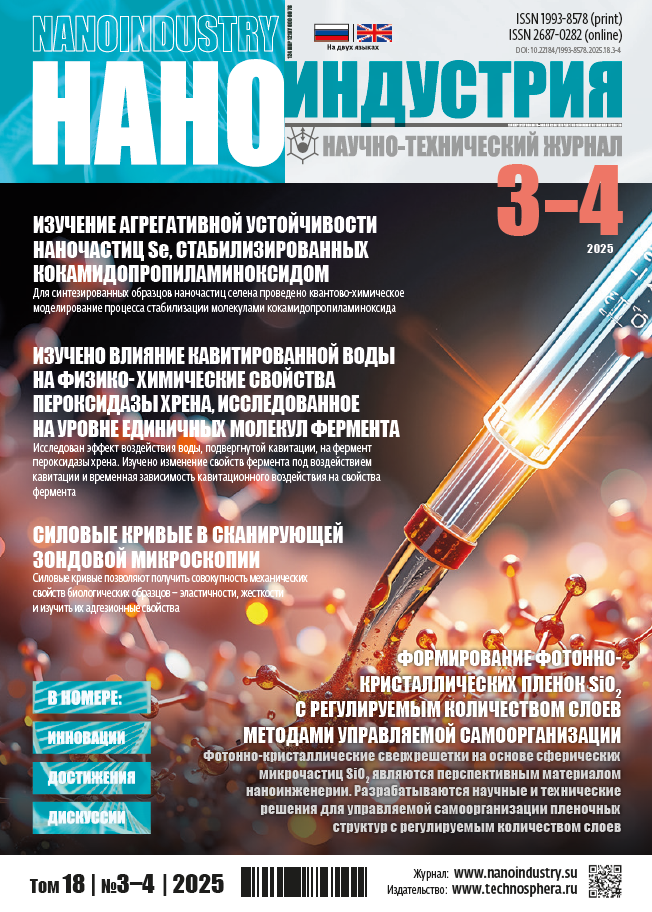Study of aggregative stability of selenium nanoparticles stabilized with cocamidopropylamine oxide
- Authors: Blinova A.A.1, Pirogov M.A.1, Rekhman Z.A.1, Blinov A.V.1, Nazaretova E.D.1, Golik A.B.1
-
Affiliations:
- North-Caucasus Federal University
- Issue: Vol 18, No 3-4 (2025)
- Pages: 174-182
- Section: Nanotechnologies
- URL: https://journals.eco-vector.com/1993-8578/article/view/684013
- DOI: https://doi.org/10.22184/1993-8578.2025.18.3-4.174.182
- ID: 684013
Cite item
Abstract
In this work, samples of selenium nanoparticles stabilized with cocamidopropylamine oxide were obtained by chemical reduction in an aqueous medium. Quantum chemical modeling of the process of stabilization of selenium nanoparticles by cocamidopropylamine oxide molecules was carried out, as a result of which it was found that this interaction is energetically favorable (∆E ≥ 2399.568 kcal/mol) and chemically stable (0.035 ≤ n ≤ 0.067 eV), and the interaction of the selenium atom with cocamidopropylamine oxide through a secondary amino group (∆E = 2400,099, n = 0.067 eV). As a result of optimization of the synthesis method, optimal concentrations of selenic acid, ascorbic acid and cocamidopropylamine oxide were determined – 0.004, 2.118 and 0.180 mol/dm3. The stability of selenium nanoparticles was also studied depending on the active acidity of the medium and the ionic strength of the solution. It has been established that selenium particles have high stability in the pH range of the medium from 1.81 to 4.56 (from 12 ± 2 nm to 24 ± 5 nm). Based on the analysis of the dependences of the average hydrodynamic radius on the ionic strength, it was found that Na+ and Cl- ions do not significantly affect the stability of the particles (R varies from 12 ± 2 to 15 ± 2 nm), and selenium nanoparticles are stable when SO42– ions with concentrations up to 0.5 mol/dm3 are added to the sol.
Full Text
About the authors
A. A. Blinova
North-Caucasus Federal University
Email: zafrehman1027@gmail.com
ORCID iD: 0000-0001-9321-550X
Cand. of Sci. (Tech), Docent
Russian Federation, StavropolM. A. Pirogov
North-Caucasus Federal University
Email: zafrehman1027@gmail.com
ORCID iD: 0000-0001-9217-6262
Laboratory assistant
Russian Federation, StavropolZ. A. Rekhman
North-Caucasus Federal University
Author for correspondence.
Email: zafrehman1027@gmail.com
ORCID iD: 0000-0003-2809-4945
Assistant
Russian Federation, StavropolA. V. Blinov
North-Caucasus Federal University
Email: zafrehman1027@gmail.com
ORCID iD: 0000-0002-4701-8633
Cand. of Sci. (Tech), Docent
Russian Federation, StavropolE. D. Nazaretova
North-Caucasus Federal University
Email: zafrehman1027@gmail.com
ORCID iD: 0000-0002-1850-8043
Laboratory assistant
Russian Federation, StavropolA. B. Golik
North-Caucasus Federal University
Email: zafrehman1027@gmail.com
ORCID iD: 0000-0003-2580-9474
Assistant
Russian Federation, StavropolReferences
- Minich W.B. Selenium metabolism and biosynthesis of selenoproteins in the human body. Biochemistry (Moscow). 2022. Vol. 87. Suppl 1. PP. S168–S177.
- Миних В.Б. Базовые аспекты метаболизма селена и биосинтеза селенопротеинов в организме человека. Успехи биологической химии. 2022. Т. 62. С. 369–90.
- Решетник Л.А., Парфенова Е.О. Селен и здоровье человека (Обзор литературы). Экология моря. 2000. Т. 54. С. 20–25.
- Шестакова Т.П. Использование селена в медицинской практике. РМЖ. 2017. Т. 25. № 22. С. 1654–1659.
- Lanza M.G.D.B., Dos Reis A.R. Roles of selenium in mineral plant nutrition: ROS scavenging responses against abiotic stresses. Plant Physiology and Biochemistry. 2021. Vol. 164. PP. 27–43.
- Yang H. et al. The beneficial and hazardous effects of selenium on the health of the soil-plant-human system: An overview. Journal of hazardous materials. 2022. Vol. 422. P. 126876.
- Lv Q. et al. Advances in research on the toxicological effects of selenium. Bulletin of Environmental Contamination and Toxicology. 2021. Vol. 106. PP. 715–726.
- Chen N. et al. Selenium nanoparticles: Enhanced nutrition and beyond. Critical reviews in food science and nutrition. 2023. Vol. 63. No. 33. PP. 12360–12371.
- Garza-García J.J.O. et al. The role of selenium nanoparticles in agriculture and food technology. Biological Trace Element Research. 2022. PP. 1–21.
- Ndwandwe B.K. et al. Selenium nanoparticles–enhanced potato starch film for active food packaging application. International Journal of Food Science and Technology. 2022. Vol. 57. No. 10. PP. 6512–6521.
- Waqar M.A. A comprehensive review on recent advancements in drug delivery via selenium nanoparticles. Journal of Drug Targeting. 2025. Vol. 33. No. 2. PP. 157–170.
- Блинов А.В. и др. Наночастицы селена, стабилизированные хитозаном, для обогащения молочной продукции. Аграрная наука. 2024. Т. 1. № 9. С. 130–135.
- Huang Y. et al. A review of selenium (Se) nanoparticles: from synthesis to applications. Particle & Particle Systems Characterization. 2023. Vol. 40. No. 11. P. 2300098.
- Блинов А.В. и др. Синтез и изучение стабилизации наночастиц селена в среде водорастворимых неионогенных поверхностно-активных веществ. Вестник Московского государственного технического университета им. Н.Э.Баумана. Серия "Естественные науки". 2024. № 2 (113). С. 103–115.
Supplementary files









